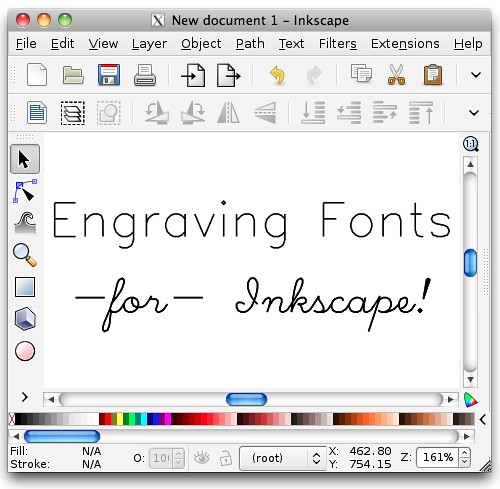
For the setGlyphIDs extension you will need to select the paths (click on one path and then Ctrl+A to select all).

Finally copy the text-string and paste as input string for Glyph IDs – set. Edit your font and make sure each glyph has one combined path. Then your string of glyph IDs are saved within the layer ‘glyphIDs’. If you are editing a font you should start running Glyph IDs – get just after generating the template with Custom Stroke Font – Edit Font. of rows = 1 as the setGlyphIds use the left bounding box for sorting. When creating a new font or editing a font using Custom Stroke Font (Create Font Design Template / Edit Font) make sure to use No. You will find these in menu Extensions > Cutlings, Glyph IDs – get… and – set…

Unzip and place the files in your User extensions folder.The zip file containing the files getGlyphIDs and setGlyphIDs.or if you have an GitLab account you could download from here.Go to my Inkscape Resources and download the zip file (arrow down button).The IDs will be ordered from left to right using the left bounding box border. SetGlyphIDs.py/.inx set all IDs of the selected paths using one by one character from the input string. When you are ready to generate your new or edited font, you can copy the content of this text object and paste as input-string to setGlyphIDs. The getGlyphIDs stores the original IDs into a text-object in a new layer ‘glyphIDs’. During editing and path manipulation these IDs and the order of the paths could easily be messed up. When editing an existing svg font using the Custom Stroke Font – Edit Font these IDs are ready to fetch. GetGlyphIDs.py/.inx fetch all path IDs of the glyphs and combine these to a continuous string. Here my extensions to fetch and set those path IDs come in handy. Then you decide to do some path editing and you might loose those IDs to new autogenerated path IDs (Inkscape 1.1 is better than previous versions). It could be quite cumbersome to fill in all those IDs. When generating a font using the Custom Stroke Font extension, each path representing a character or glyph need to have an ID equal to the corresponding glyph.

I have also written extensions of my own to streamline this process. I have created some fonts using the Custom Stroke Font extension in Inkscape.


 0 kommentar(er)
0 kommentar(er)
